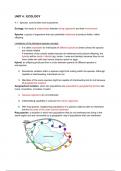Summary
Summary IB Biology HL Topic 4 Ecology Notes
- Course
- Biology
- Institution
- 12th Grade
Well organised notes that includes all crucial information needed for IB Biology. Easy to understand, follows the IB syllabus points, includes examples that can be useful in tests.
[Show more]



